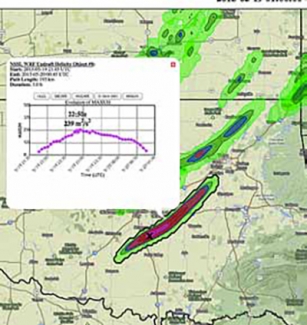Through its Visitor Program, the DTC is currently working with Adam Clark, a scientist at the Cooperative Institute for Mesoscale Meteorological Studies (CIMMS), on a project that involves using the Method for Object-based Diagnostic Evaluation – Time Domain (MODE-TD) for identification, tracking, and visualization of simulated supercells in high-resolution models, which will be applied and tested during annual NOAA/Hazardous Weather Testbed Spring Forecasting Experiments.
Supercells are identified using updraft helicity (UH) extracted at 5-minute intervals from an experimental 4-km grid-spacing version of the WRF model run in real-time at the National Severe Storms Laboratory (NSSL), which is known as the NSSL-WRF. The UH extraction is done using a newly developed technique that minimizes data volume, and supercells are defined based on maximum intensity and longevity criteria applied to UH objects identified by MODE-TD. Geographic information and object attribute information are then combined into the GeoJSON file format and displayed using an experimental web interface developed in collaboration with Chris Karstens of CIMMS/NSSL, known as the NSSL Experimental Data Explorer. The image above is a screenshot from the data explorer showing the path as depicted by UH and associated attributes of a simulated supercell over central Oklahoma 19 May 2013.
